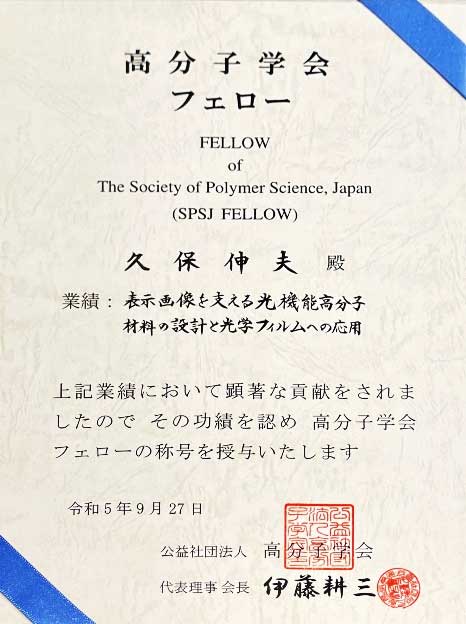Topics
A Konica Minolta Engineer Selected as a FELLOW of the Society of Polymer Science, Japan for Achievements in Optical Films
October 20, 2023
Tokyo (October 20, 2023) – Konica Minolta, Inc. (Konica Minolta) announced that one of its R&D engineers won the title of SPSJ FELLOW for FY2023 from the Society of Polymer Science, Japan (SPSJ) for his achievements in the field of optical films.
The SPSJ is a public interest incorporated association established to promote basic research on polymer science and technology, contribute to the progress of practical applications and the development of scientific culture, and develop human resources in these fields. At present, the scientific organization has over 10,000 members. Established in 2007, the title of FELLOW is awarded to members, regardless of whether academic or corporate researchers, who have made achievements in the development of the abovementioned fields and who are expected to make contributions in the future.
Award Winner and His Achievement
Dr. Nobuo Kubo
Technology Development Headquarters, Konica Minolta, Inc.
“Design of optical function polymer materials that underpin display images, and applications to optical films”

Details of Achievements
With flat-panel displays (FPDs) evolving alongside developments in the communication infrastructure, Konica Minolta focused on liquid crystal displays (LCDs), one type of FPD, and entered the market of triacetyl cellulose (TAC) films for protective films for LCD polarizers in the late 1990s. As the size of LCDs grew, a wider viewing angle became necessary. Films for wide view (retardation films), with liquid crystal molecules applied on TAC, became widespread in the market.
Kubo believed that a certain drawn cellulose film with high birefringence development behavior was “optically equivalent” to a TAC film to which liquid crystal molecules were applied. The single film of drawn cellulose had two functions: protection of polarizers and wide viewing angle. There were high expectations for the technology because it (1) achieved a wide viewing angle with a film thinner than TAC, (2) enabled production in the TAC film-casting process, (3) achieved laminating with polarizers using an aqueous adhesive as in the case of TAC, and (4) eliminated the process of laminating a retardation film on a polarizer.
In the 2000s, LCDs were increasingly used for large-screen TVs, and drawn cellulose film technology was used to achieve a wider viewing angle of multi-domain vertical alignment (VA) mode LCDs. Today, the technology continues to play a key role in Konica Minolta’s main products.
Kubo made engineering contributions to realizing a very simple but useful optical film by understanding the mechanism of LCDs, achieving a preferred display image and ensuring harmony with the polymer material design. In the activities of technology research association and scientific associations and societies, Kubo worked on public interest activities in the domain of materials related to optical functions to contribute to the development of the field. These efforts were highly evaluated by the SPSJ.
